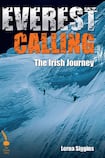
All mountaineers share values to do with self-reliance, judgment, decision-making and resilience. Nowhere are these more sought than at high altitude. Most mountaineers, when describing a mountain, will give you an incredibly detailed account of their route, their use of equipment, the character of the rock, the weather, the condition of the mountain. Often the last thing they will tell you, if they do so at all, is what it was like at the summit.
Twenty years ago, the season was already over. The Irish were the last expedition on the mountain. Alone, with no footprints, no Sherpas and no guides, and only his own years of climbing and resilience to maintain momentum to the top of the world, Dawson Stelfox became the first Irishman to stand on the summit of Qomolangma, as Mount Everest (8,848m) is known in Tibet, on May 27th, 1993.
Everest Calling: The Irish Journey is not just a story of one man reaching the top of the world; it is also one of challenge, commitment and togetherness by an Irish expedition team. Its author, the Irish Times journalist Lorna Siggins, with one of the expedition members, Dermot Somers, details the most captivating and inspiring aspects of the 1993 "siege" of Everest.
The foundation for the expedition was laid years earlier, first with the expedition to Changtse (7,543m) in 1987 and then, in 1991, with an attempt on Manaslu (8,156m), the world’s eighth-highest mountain. In neither case did the climbers reach the summit, but lessons were learned for Everest: minimise expectations, consider the style, and ensure compatibility. Joss Lynam (1924-2011), the leader of the Changtse expedition, was a leading figure in bringing together the technically skilled and those who also had organisational skills.
Siggins chronicles the selection of the Everest team, which in itself proved contentious. But with experience acquired, team members recruited and Stelfox identified as the leader, the momentum for the Everest attempt kept building.
Making an expedition happen, especially one to Everest, required significant fundraising, so commercial sponsorship was a requirement that even the purists had to accept. Colgate, Aer Lingus, Cospóir, groups of trekkers to base camp and many others made the expedition possible.
Reluctant to be called leader – he preferred co-ordinator – Stelfox took a purist approach: the expedition would be unsupported, with no oxygen and no Sherpas. Earlier experiences had taught lessons, and eventually oxygen was accepted, but the entire team was clear that no Sherpas were going to be endangered. The team would be self-sufficient above 6,500m, “carrying all food and equipment without Sherpa support”.
The team was determined that Everest was going to be climbed in good style. The “siege” approach, or Himalayan-style sleep-low-climb-high strategy, setting camps progressively until the summit is reached, was decided on, as opposed to alpine style, which involves climbing lightly and quickly.
The siege was deliberate and meticulously planned, building on the harsh lessons the climbers had learned during earlier expeditions, when losses and unclimbed peaks seemed to be the almost certain outcomes of Irish high-altitude mountaineering.
The whole climbing team – Mike Barry, Tony Burke, Robbie Fenlon, Mick Murphy, Frank Nugent, Richard O’Neill-Dean, Somers and Stelfox – supported each other tirelessly to create an opportunity for some or any one of them to make it to the top.
Nugent partnered Stelfox on summit day but had to make the difficult decision to turn back as he gasped for air, with his control slipping away. Stelfox continued alone, traversing, climbing, plodding, reaching the Second Step, steep slabs, snowfields and on to the top of the world.
Stelfox was elated and felt honoured, but he knew the journey was not complete, and the descent proved difficult. Stelfox struggled to find the route and keep his mind focused. The next day Fenlon and Burke made it to 8,500m; Fenlon could have reached the summit had conditions been favourable.
Mountains have always been symbols of challenge – intertwined in conflicts and vantage points in war – and mountaineers have always climbed. The significance of the 1993 Irish expedition was not lost on those who recognised the importance of its cross-Border mix, without a flag, and how it was embraced throughout the island, largely due to The Irish Times and Pat Kenny's RTÉ radio show.
As Stelfox held dual citizenship, some found it difficult to fully embrace his success, which was not only a first Irish ascent of Everest but also a first British ascent via the North Ridge, where George Mallory and Andrew Irvine had perished in 1924.
But President Mary Robinson was “euphoric” and said that the team provided “a very good role model for the island of Ireland”. Likewise, Buckingham Palace recognised the all-island success: the letter from the queen’s secretary read, “The queen has heard of your splendid achievement in becoming the first Irishman to climb Everest, and the first British climber to make the ascent via the North Ridge”.
Somers reflects critically on the “summiteering” of Everest, which has increased apace since 1993, with, in many cases, mountaineers’ core values of self-reliance and decision-making being replaced by a client-guide relationship. Somers argues that the “system is at its weakest when a chain of novices is ushered up and down an 8,000m mountain – a danger to themselves and their guides”.
Everest Calling: The Irish Journey is a rewrite of Siggins's 1995 book, Everest Calling: Ascent of the Dark Side – The Mallory-Irvine Ridge . The new volume reflects not just on the Everest ascent but, equally, on a generation of Irish mountaineers, their ethos and what their expedition meant at that time to the people of this island.
Additionally, Siggins reports on the onward journey of the individual members of the expedition team and where they are now. The book also summarises the achievements of the Irish who have subsequently summited Everest.
Whether it is adventure that drives you or social history that grips you, or you are simply seeking a well-written, easily read, inspiring story, this should be on your list.
Karl Boyle is the chief executive officer of Mountaineering Ireland and was formerly an officer of the Irish Defence Forces.










